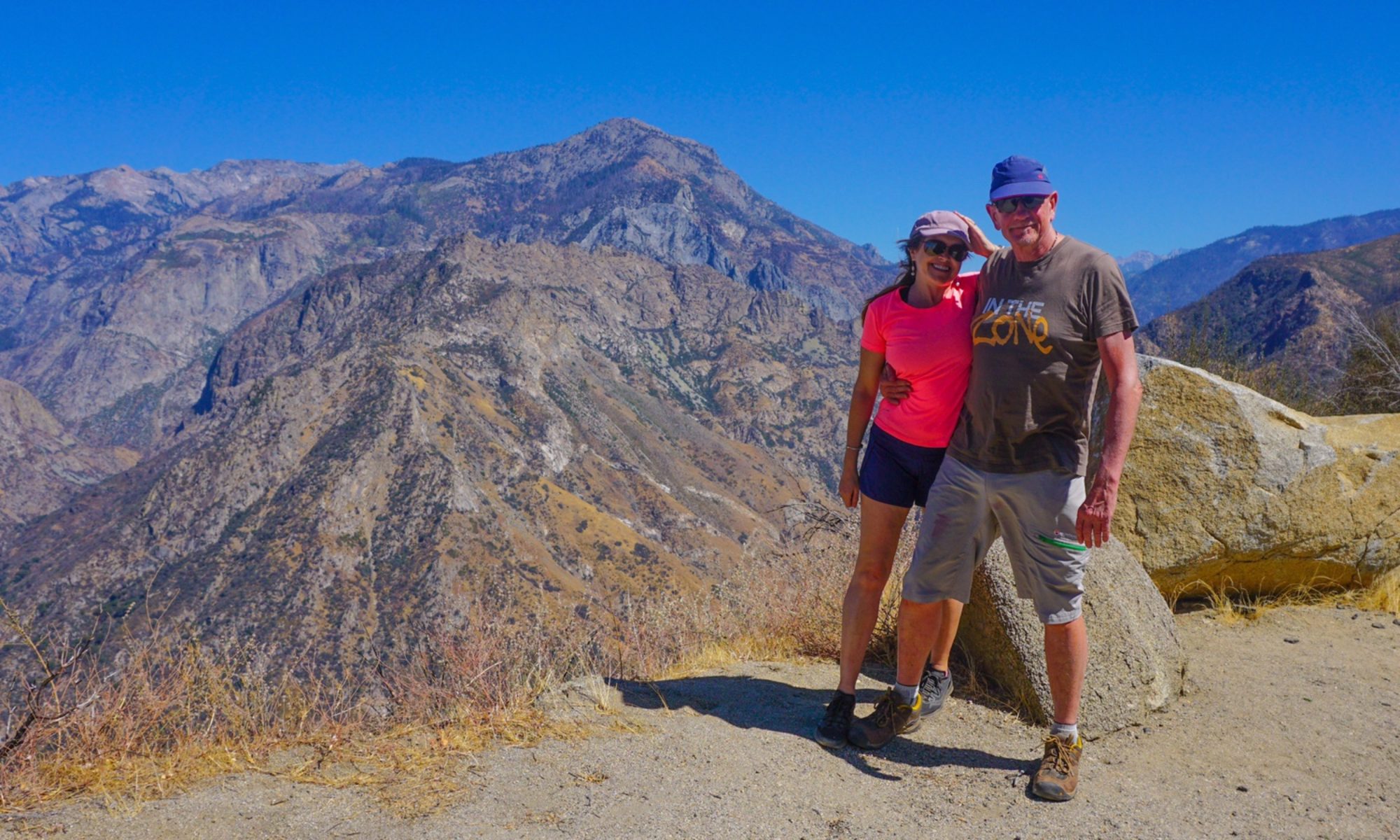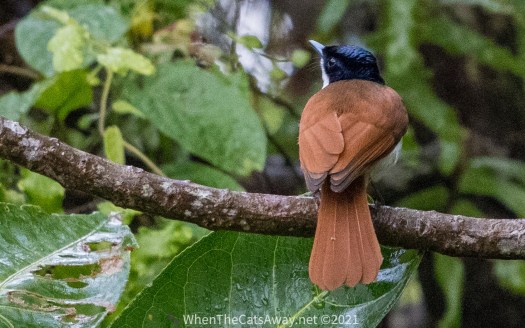It was just over an hour’s journey to our next and final destination travelling north up the Queensland east-coast, deeper into the Daintree Rainforest and up towards Cape Tribulation. This area was called Kurangee by the Kuku Yalanj First Nations people, meaning ‘place of many cassowaries’. If it was up to us we would call it ‘place of many greens’ – that is certainly the dominant colour up here.
We thank and recognise the Kuku Yalanj people, present and past, for their custodianship over these lands upon which we stayed, travelled and explored.

We set up camp at Daintree Rainforest Village, a site that had only newly opened when we last came up this way in 2018. We were pleased to see they had accepted some of our then recommendations, with a roomy camp kitchen and dining area plus landscaped campfire social space. The grounds of the camp are beautifully planted with a steep terraced garden with views over the rainforest attracting birds and wildlife.




In the early evening we were delighted to see the endangered Spectacled Flying Foxes, a type of fruit bat, swooping in to the treetops around the campground to feed. They have been listed as threatened for more than 20 years, but slipped on to the endangered list in 2019 after a third of the population died in an extreme heatwave where temperatures exceeded 42 degrees centigrade. We hope they don’t become another casualty of climate change.


We were staying a short drive from Cow Bay, a locality which includes a beautiful rainforest lined beach, tea plantation and two tropical fruit ice cream stalls. A fine area to visit indeed, if only for the ice cream (and sorbet!). We love the tea from up here too, and ensured we purchased some.



We were excited to receive an invitation for lunch from the owners of some luxury holiday accomodation at Cape Tribulation, Mist.
Miff, Paul and Toffee (the rather beautiful English Cocker Spaniel) opened Mist about four years ago and have created a stunning tropical haven with the luxuries of air conditioning, private holiday cabins, each with a barbecue and unparalleled views of the rainforest. Miff is a good friend of several of our friends – our paths have crossed on multiple occasions in the past, but usually in large crowds involving several glasses of wine, so we didn’t know each other well. This didn’t matter though, we were greeted like old friends.

After hearing all about Miff and Paul’s incredible journey to reach this point over a delicious lunch at a local cafe, we were given the VIP tour of the grounds…or at least until the heavens opened and we couldn’t stay outside any longer, especially with camera equipment.
Many of the palms, trees and plants on their property are incredibly rare, and botanists have taken cuttings and samples which now grow in the Cairns Botanic Gardens. As we left the gardens and entered the pristine rainforest, thick vines twisted up into the canopy – these have been dated to more than five hundred years old. A very special location indeed.

Miff was particularly excited to show us a blue pool, an aboriginal sacred site which was used by women for healing and birthing ceremonies. She had requested and gained permission from the Kuku Yalanj people to share this with guests., however the wet weather meant the only female jumping in this pool on this occasion was Toffee!


As we headed back to camp, the exotic fruit stand at the bottom of their road gave us a chance to sample some unusual samples. The Black Sapote is like chocolate mousse – especially when whipped up with a spoonful of yoghurt – delicious.

While this area may be known as ‘the place of many cassowaries’ you are lucky to spot one of these mysterious creatures. I had been fortunate to see one from the inside of a coach on my very first visit here while backpacking around Australia, way back in 1999, but since then they have eluded us.
The Southern Cassowary is a large flightless bird, a distant cousin of the Emu, Ostrich and the New Zealand Kiwi. Colloquially they are often jokingly known as ‘the murder chicken’ because of their 20cm long dagger claw which could easily disembowel and kill anything they see as a threat. It is therefore wise to ensure you particularly keep away from any birds with chicks, and never make them feel cornered.

Cassowaries live in the rainforest consuming forest fruits which would mostly be poisonous to us humans but due to their specialist gut can be safely eaten by them. A large proportion of fruiting trees and plants rely solely on their seeds passing through these birds in order to germinate.
(Photo source: Australian Museum, Creative Commons)
So we were excited to finally spot one at the edge of the rainforest, fittingly on our wedding anniversary as we drove out to the Daintree Discovery Centre on a bird spotting mission. She soon disappeared back into the forest, seeming to almost melt into the dense thicket of leaves and palms, but we were so pleased to have witnessed her presence.

Feeling buoyed by this early morning sighting, we were some of the very first visitors to the centre. Following the raised boardwalk we climbed up a tower for a fine view of the forest.



We saw flocks of Australia’s smallest parrot – the Double-eyed Fig Parrot feeding on fruit high up in the canopy, but none kind enough to fly close enough for a photo. Hopefully on the Atherton Tablelands – we have been given a few tips!
We took ourselves up to Cape Tribulation’s ‘best’ restaurant, Whet, for a celebratory lunch. There we enjoyed a couple of glasses of sparkling wine and some tasty food to toast 19 years of marriage. While there have been both ups and downs throughout this time, I can safely say the positives far outweigh any negative times, and I feel so fortunate to have met my soulmate and best friend all those years ago. It helps us to weather storms together and is how we are able to live in an 18 foot six inch long box for all this time without murdering one another!


Cape Tribulation is the main village in this part of the coast, with several accomodation options, a very quiet backpackers (I remember staying here in August 1999!), our friends’ luxury cabins at Mist, plus a couple of small shops. The white sand beach is lined with coconut palms and crocodile warning signs!

There are a number of short educational boardwalks to help visitors interpret the impenetrable forest, which were well worth doing.
Madja Boardwalk takes you through the mangroves alongside Noah Creek – at low tide a frenzy of activity as birds flit through hunting insects or hunting the little crabs that emerge to feed on the mud.



Dubuji Boardwalk starts in Cape Tribulation village and is often where people sight Cassowaries. It winds through the forest, through varied ecosystems.

The Daintree Coast is home to 16 palm species which can tolerate low soil oxygen levels better. than most other rainforest plants, therefore often are found in flood zones. The almost 2 metre wide Fan Palm fronds look almost like umbrellas spread out, and indeed Sunbirds sometimes shelter under these during a downpour.



We had a wonderful immersion in this incredibly special location, feeling privileged we could spend our 19th wedding anniversary in such unique surroundings. We so hope that this area remains unspoilt, and that climate change can be slowed to help wildlife adapt.
Out of five days here we had just one where it didn’t rain, but then that is what you get in the rainforest, even during the dry season. Apparently they are expecting an early wet season this year…we can only imagine what that’s like!
*A forthcoming prize to whomever can first name the comedy from which the title quote comes from 🙂

















































